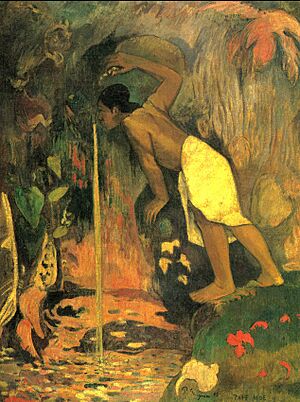Māhū facts for kids
Māhū (pronounced "MAH-hoo") means 'in the middle' in the Hawaiian and Tahitian languages. In these cultures, Māhū are people who have special traditional roles in society and spiritual life. They are similar to fakaleiti in Tonga and fa'afafine in Samoa.
Māhū were highly respected, especially as teachers of hula dance and traditional chants. Long ago, before Europeans arrived, Māhū would perform important roles in hula dances held in temples. These temples were often places where women were not allowed. Māhū were also important for keeping cultural traditions alive, like sharing family histories. Sometimes, parents would even ask Māhū to name their children.
History of Māhū
In the history of Hawai'i, before it became a colony, Māhū were often important priests and healers. However, much of this history was changed or forgotten after missionaries arrived. Some people also say that Māhū did not have political power or leadership roles.
The first written description of Māhū comes from Captain William Bligh's logbook. He was on the ship Bounty and visited Tahiti in 1789. He wrote about a group of people called "Mahoo" who were very common there. He noted that they were men but had very gentle or soft ways.
A special monument to this history is found on Waikiki Beach. These are the "Wizard Stones" of Kapaemāhū. They honor four important Māhū who first brought healing practices from Tahiti to Hawaiʻi. A Hawaiian historian named Mary Kawena Pukui called them pae māhū, which means a row of Māhū.
In 1891, when the painter Paul Gauguin first came to Tahiti, the local people thought he might be a Māhū. This was because of his colorful and unusual way of dressing at the time. His painting from 1893, Papa Moe (Mysterious Water), shows a Māhū drinking from a small waterfall.


